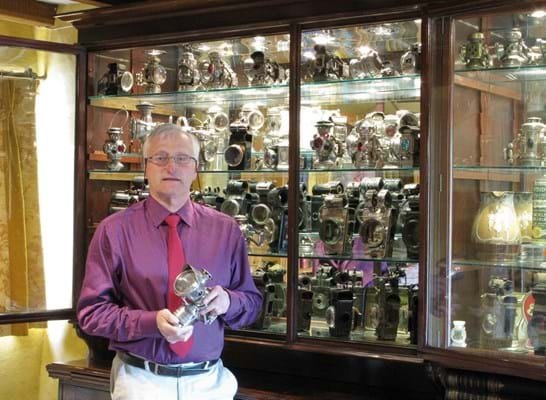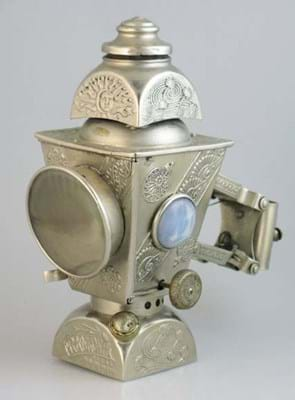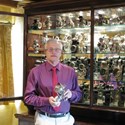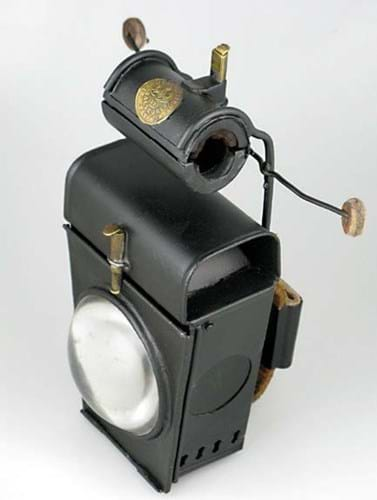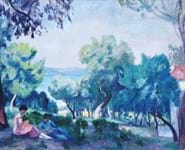In the latest of our occasional series of collector interviews, we talk to Peter Card who has assembled 500 early bicycle lamps during his long career.
He has published several books on the subject including Early Vehicle Lighting (1987 & 2004) and Early Cycle Lighting 1868-1948 (2007). As well as belonging to several trusts and societies, he now owns and runs Transport Collector Auctions and has previously worked at Phillips and Bonhams.
ATG: What was the first bicycle lamp you bought?
Peter Card: In 1964 I attended a Scouts’ jumble sale and a friend purchased an oil-powered bicycle lamp in fabulous original condition for sixpence.
I was very taken with its quality, but he refused to sell it to me. Then, about six months later when he needed a little money, I bought it from him for 25 shillings – a profit of something like 500%.
Was that when the collecting bug started for you?
I already knew by then that I wanted to collect something, but I wasn’t sure what. The spirit of collecting is inbuilt – it’s in your genes.
My twin brother and I were fostered as babies, and our collecting was of considerable irritation to our foster parents. It was ‘hoarding’ according to them, but when we were 13, they bought us the best birthday present: a garden shed to keep everything in.
That was when I started thinking I should focus on one area. For my brother it was clocks.
And you’re still buying today?
No, my obsession with amassing new pieces ended about 10 years ago.
After reaching 500 lamps I woke up one day and realised I had to put a stop to it, particularly with prices rising. I am now down to a more manageable 400.
I keep a little over 100 in the lamp room in my home, along with files of research material and documents. The rest are boxed up, but not forgotten.
“I looked through patent books that had never been opened – the joy of putting together a story that no-one had told before was liberating
What are the parameters of the collection?
Around 90% of the bicycle lamps I collected precede the First World War, though I do have a few later examples to show how designs and manufacturing techniques have changed.
The earliest lamps were made for French velocipedes from about 1869, but I don’t have anything that early: the oldest in the collection dates from 1876.
How are bicycle lamps categorised?
Generally, they can be divided into five main categories.
The earliest used candles. These weren’t popular – I can attest from personal experience that it is almost impossible to keep these alight in even the gentlest of winds.
Then there were oil-powered lamps, which give a pure but flickering light yet remained the most popular medium.
Around 1896, carbide of calcium (acetylene gas) was reinvented and gave a very bright light, followed by battery electricity c.1899 (this had been launched earlier, c.1888, but was initially very expensive).
Finally, it was the Dynamo, usually driven by a spinning wheel, the strength of light varying depending upon one’s speed.
How has the trade changed since you’ve been collecting?
The major change has been eBay.
When I first started, there weren’t that many people in the field. Since then I’ve authored several books on the topic and when people realised, as I had many years earlier, that early bicycle lamps were superbly designed and manufactured, they started buying them on eBay and the market took off.
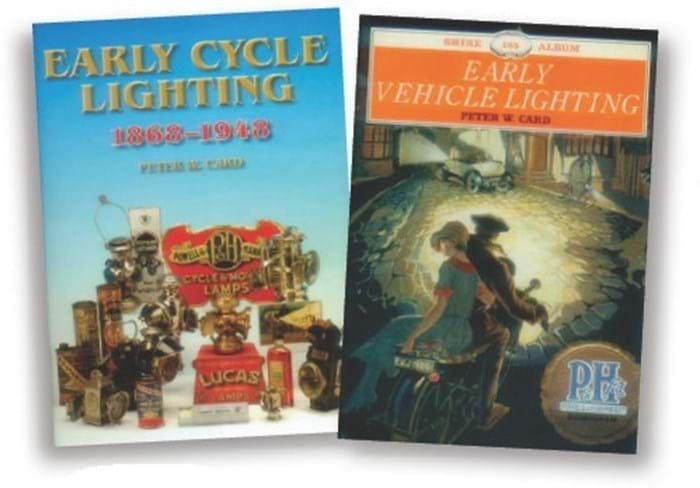
Two of Peter Card’s books.
In fact, that’s part of the reason I stopped buying – eBay drove the prices up so examples I used to pay a few shillings for now sell for hundreds of pounds, while the more unusual and rarest types can command thousands.
How hard was it to stop collecting?
It was very difficult to make the decision. I enjoyed the process of collecting, but I also enjoy research and writing on the subject.
I’m sitting in my lamp room now, surrounded by cabinets and I can look up from my computer and remember the joy of discovery.
And while it’s great collecting the hardware itself, what really enhances one’s collecting experience is investigating the history.
I’ve done a lot of research with manufacturers’ catalogues, exploring advertisements and trying to identify when various models first appeared and why they were successful or failed.
I also worked closely with Peter Mann at the Science Museum and would spend a lot of the time in the periodical library in Hendon (now in Yorkshire).
The patent office library was a significant source of information, looking through patent books that had never been opened before – the joy of putting together a story that no-one else had told before was liberating.
Your advice to new collectors?
Adopt a theme and do not become obsessional. There is so much material available. At every antique fair there will be a lamp or two, usually either oil or acetylene gas.
Buy the best you can afford – a good lamp from the 1920s will be £50-80 while Victorian examples can be several hundreds of pounds.


